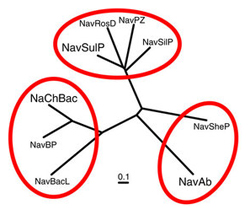Research Abstract
原核生物の四量体ナトリウムチャネルのC末端にあるヘリックスバンドルは不活性化を促進する
The C-terminal helical bundle of the tetrameric prokaryotic sodium channel accelerates the inactivation rate
2012年4月24日 Nature Communications 3 : 793 doi: 10.1038/ncomms1797

四量体チャネルのほとんどが細胞内ドメインを持っており、それがチャネルの不活性化などの活性調節にかかわっている。本論文では、Sulfitobacter pontiacusからクローニングされた原核生物由来の電位依存性ナトリウムチャネルであるNavSulPの細胞内に存在するC末端領域が、チャネル不活性化を促進することを明らかにした。NaKチャネルのC末端に接合したNavSulPのC末端領域の結晶構造解析から、NavSulPのC末端領域は4本のへリックスからなるバンドルを形成していることがわかった。4本へリックスバンドルのサブユニット間相互作用にかかわっている残基に点変異を導入すると、チャネル四量体が不安定化し、不活性化の速度が低下した。4本へリックスバンドルは、ポアドメインの内側ヘリックスに連結していて、その内側へリックスの剛性を増すような変異も不活性化の速度を低下させた。これらの知見は、NavSulPの4本へリックスバンドルは四量体の安定化に重要な役割を持つだけではなく、内側へリックスのコンホメーション変化の促進を介して不活性化を加速していることを示唆している。
- 京都大学大学院理学研究科 生物科学専攻 生物物理学教室.
-
バイオ産業情報化コンソーシアム
*現所属: 名古屋大学細胞生理学研究センター
Most tetrameric channels have cytosolic domains to regulate their functions, including channel inactivation. Here we show that the cytosolic C-terminal region of NavSulP, a prokaryotic voltage-gated sodium channel cloned from Sulfitobacter pontiacus, accelerates channel inactivation. The crystal structure of the C-terminal region of NavSulP grafted into the C-terminus of a NaK channel revealed that the NavSulP C-terminal region forms a four-helix bundle. Point mutations of the residues involved in the intersubunit interactions of the four-helix bundle destabilized the tetramer of the channel and reduced the inactivation rate. The four-helix bundle was directly connected to the inner helix of the pore domain, and a mutation increasing the rigidity of the inner helix also reduced the inactivation rate. These findings suggest that the NavSulP four-helix bundle has important roles not only in stabilizing the tetramer, but also in accelerating the inactivation rate, through promotion of the conformational change of the inner helix.

